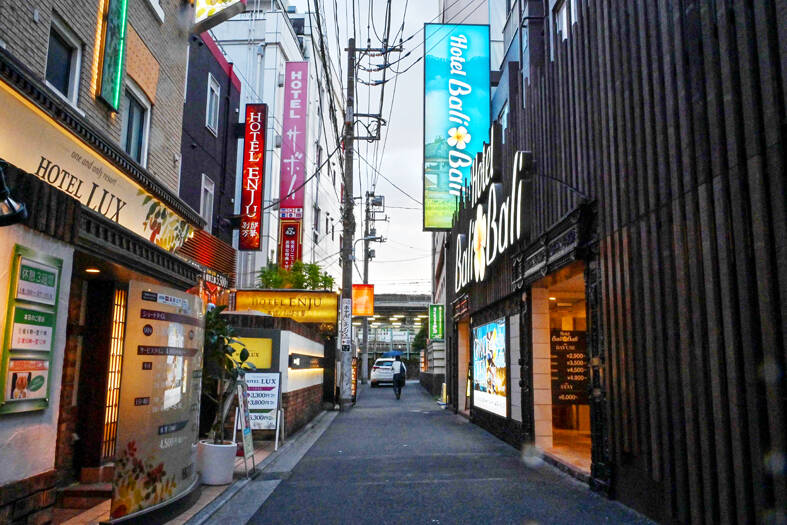Do whales make you horny? How about UFOs? Maybe you’ve always dreamed of having a tryst in a fairytale castle, or making love inside a gigantic biscuit tin? Whatever your weird fantasy may be, it can probably be catered for on a roadside somewhere in Japan, if a new book on the curious phenomenon of love hotels is anything to go by.
French photographer Francois Prost has been on a 3,000km pilgrimage of passion, driving from Utsunomiya, north of Tokyo, to the island of Shikoku in the south, to document Japan’s unique architecture of furtive liaisons. What he found spans from manga-embellished motels and Christmas-themed love nests to pastel-hued stage sets worthy of Wes Anderson. And some things stranger than your most eccentric kinks could dream of.
“I find love hotels culturally fascinating,” says Prost, whose previous projects have included photographing the facades of strip clubs in the US and nightclubs in Ivory Coast. “Japan is generally a fairly conservative society, but these are places of escapism, fantasy and almost childlike wonder. And you find them everywhere.”

Photo: AFP
Estimates vary, but some put the number of love hotels — or rabu hoteru — in the country as high as 37,000. They pop up in city centers and rural villages, at busy highway junctions and secluded among fields in the middle of nowhere. As Prost’s photographs show vividly, they come in all shapes, sizes and stylistic genres.
Some are modeled on castles, topped with pink crenelations and turquoise turrets. Some look like alpine chalets, others like tiki huts, while plenty are modeled on cruise ships, promising to take you on a voyage to love paradise. Whether French chateaux get your juices flowing or you have a penchant for Arabian onion domes, there’s a place waiting for you to be greeted by an anonymous receptionist, pay for a kyukei, or “rest”, and live out your carnal dreams.
While most of the buildings in Prost’s book date from the 1960s onwards, the Japanese love hotel has its origins as far back as the 1600s. They began to emerge during the Edo period, in the form of discreet establishments known as deai chaya, or lovers’ teahouses, where couples could meet away from the prying family gaze.
They looked like regular teahouses from the outside, but were designed with secretive entrances and multiple exits, and — crucially, for a shoes-off-at-the-door society — somewhere for customers to hide their footwear so as not to be identified.
By the early 20th-century Showa era, these teahouses had transformed into themed, colorful places that offered a sense of escape from the daily routine. Japan’s postwar economic boom saw love hotels blossom into elaborate sexual amusement parks in the 1970s and 80s, with themes ranging from fairytale to sci-fi to medieval cosplay.
The country’s high population density, small apartment sizes and tradition of living at home until marriage helped fuel the appetite for places for people to meet in private. Some have also put love hotels’ continuing success down to the sexual liberation of women in Japan, sometimes highlighting the cute, cartoonish nature of the decor — designed to feel safe and inviting, rather than tacky and sordid.
Quite different from seedy pay-by-the-hour motels elsewhere in the world, love hotels aim to cater to everyone. In his 2005 book, Law in Everyday Japan, legal scholar Mark D West estimated that Japanese couples make more than half a billion trips to love hotels each year, suggesting that as much as half of all sexual intercourse in Japan could be taking place in these establishments. In turn, that would mean that a good deal of the country’s population were conceived on a rotating bed, in a beshackled boudoir, or inside a fantastical tropical grotto surrounded by model dinosaurs.
Prost’s photographs don’t take you inside the bedrooms (there are other books for that), but instead focus on the exterior iconography of the hotels. Far from fading into the background, they stand as loud roadside billboards, designed to be easily identifiable by libidinous couples at a glance from a moving vehicle.
Who could miss the Hotel Artia Dinosaur, which rises on the corner of a highway intersection in Machida city near Tokyo, crowned with a huge T rex? A tableau of a Jeep being crushed by a velociraptor at the entrance sets the tone. Online reviews warn that the bedroom doors lock automatically once you’re inside, and you have to call reception to be let out – a feature common to love hotels, but here adding an extra frisson of danger, in tune with the Jurassic Park-inspired theme.
Or might you live out your Moby-Dick fantasy at the huge pink concrete whale of Hotel Festa Qugiela, in Okayama, which waits ready to swallow you inside its grinning mouth? Or embrace the kinky King Kong spirit at the LaLa Resort in Kobe? It features a massive gorilla climbing up its bright red and orange-striped facade, and a model tiger keeping watch over the underground car park (a common feature so punters can be shuttled directly to their rooms).
“The hotels are often designed so you don’t have to cross paths with anyone else,” says Prost. “You can go straight from your car into a lift going up, and there is always a separate lift to go back down, to avoid bumping into people. A lot of the hotels don’t even have receptionists any more — you book online, or choose your room from an automatic vending machine.”
The faded decor and tatty appearance of many of the establishments makes you wonder if love hotels are becoming a thing of the past. A lot of them have the forlorn look of semi-abandoned amusement parks, with flaking paintwork and sun-bleached signage. And some of the online reviews don’t inspire much confidence.
Who could resist the lure of Shibuya’s Sweets Hotel, a pink battenberg fantasy dripping with huge slices of cake, cookies and plastic icing? It turns out those aren’t the only treats on offer. “I found a pillow with dried semen,” reads one review. “The walls and doors were covered in scratch marks,” says another, “more fitting for a murder hotel than a love hotel.” “This place is gone now,” adds the most recent entry. “Too bad.”
Despite some seedy failures, Prost says that love hotels are still just as popular as ever, and they are evolving to keep up with changing habits.
“Nowadays, many young people go to love hotels to have parties,” he says. “They have karaoke machines, big TVs, massage chairs and hot tubs — people rent them in groups for a few hours.”
The Bali An group, for example, offers big rooms for joshi-kai, or girls’ nights out, complete with bars, 75-inch TVs and eight-person beds. The rooms also come with hammocks and camping equipment. After castles, cruise ships and cartoons, glamping appears to be the latest love hotel design trend, so you can sample the romance of the great outdoors without venturing outside.

Seven hundred job applications. One interview. Marco Mascaro arrived in Taiwan last year with a PhD in engineering physics and years of experience at a European research center. He thought his Gold Card would guarantee him a foothold in Taiwan’s job market. “It’s marketed as if Taiwan really needs you,” the 33-year-old Italian says. “The reality is that companies here don’t really need us.” The Employment Gold Card was designed to fix Taiwan’s labor shortage by offering foreign professionals a combined resident visa and open work permit valid for three years. But for many, like Mascaro, the welcome mat ends at the door. A

Last week gave us the droll little comedy of People’s Republic of China’s (PRC) consul general in Osaka posting a threat on X in response to Japanese Prime Minister Sanae Takaichi saying to the Diet that a Chinese attack on Taiwan may be an “existential threat” to Japan. That would allow Japanese Self Defence Forces to respond militarily. The PRC representative then said that if a “filthy neck sticks itself in uninvited, we will cut it off without a moment’s hesitation. Are you prepared for that?” This was widely, and probably deliberately, construed as a threat to behead Takaichi, though it

Nov. 17 to Nov. 23 When Kanori Ino surveyed Taipei’s Indigenous settlements in 1896, he found a culture that was fading. Although there was still a “clear line of distinction” between the Ketagalan people and the neighboring Han settlers that had been arriving over the previous 200 years, the former had largely adopted the customs and language of the latter. “Fortunately, some elders still remember their past customs and language. But if we do not hurry and record them now, future researchers will have nothing left but to weep amid the ruins of Indigenous settlements,” he wrote in the Journal of

If China attacks, will Taiwanese be willing to fight? Analysts of certain types obsess over questions like this, especially military analysts and those with an ax to grind as to whether Taiwan is worth defending, or should be cut loose to appease Beijing. Fellow columnist Michael Turton in “Notes from Central Taiwan: Willing to fight for the homeland” (Nov. 6, page 12) provides a superb analysis of this topic, how it is used and manipulated to political ends and what the underlying data shows. The problem is that most analysis is centered around polling data, which as Turton observes, “many of these